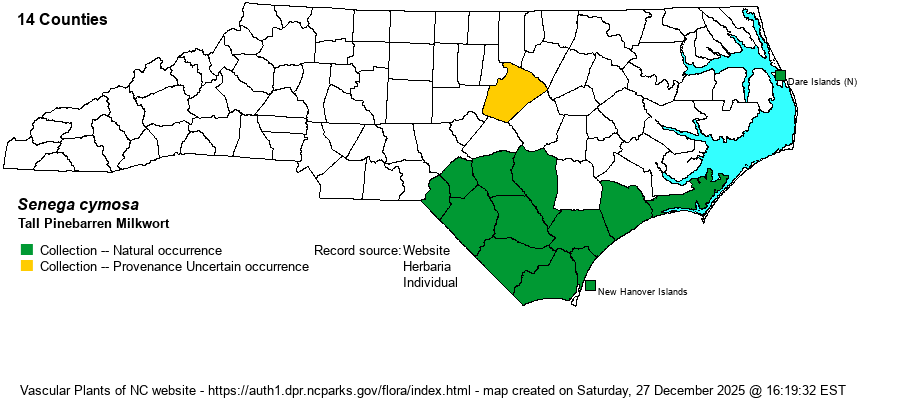| Author | (Walter) J.F.B. Pastore & J.R. Abbott | |
| Distribution | Present essentially only in the southern Coastal Plain, with an outlier (historical) collection from Roanoke Island in coastal Dare County. It occupies the flat portion of the Coastal Plain, with a single occurrence in a depression pond on Fort Bragg within the Sandhills proper. A collection from Wake County is perhaps not natural.
This is a Coastal Plain species, occurring in DE, and then from southern NC south to southern FL and west to eastern TX. | |
| Abundance | Uncommon to infrequent, but rare in the Sandhills portion of the Coastal Plain. | |
| Habitat | This is a species of shallow, ponded waters, mainly associated with cypresses and pines. It occurs in cypress ponds, clay-based bays, limesink ponds, and other pineland pools. | |
| Phenology | Blooms from May to July, and fruits shortly after flowering. | |
| Identification | This is a quite tall Senega, usually reaching 2-3 feet tall on a solitary stem, though there are many short branches in the inflorescence. It has a basal rosette of leaves that are lanceolate to linear, about 2 inches long but quite narrow, and entire. It has numerous alternate stem leaves, ascending, and linear, shorter than the basal leaves -- such that the long stem looks rather "naked". The inflorescence has numerous branches, with the flower clusters rounded to flat-topped, 4-5 inches wide, consisting of several dozen individual racemes of densely packed bright yellow flowers. S. ramosa is somewhat similar, but it does not grow in standing water of pools, the basal leaves are smaller, elliptical, and rounded at the tips; it is much shorter (always less than 1 foot tall), and the inflorescence is much less dense and wide. This is quite a spectacular plant, as it can reach almost waist height, with numerous racemes of bright yellow flowers forming a flat-topped appearance. | |
| Taxonomic Comments | All of the former Polygala species in NC have now been moved to the genus Senega in 2023. | |
| Other Common Name(s) | None | |
| State Rank | S3 | |
| Global Rank | G5 | |
| State Status | | |
| US Status | | |
| USACE-agcp | | |
| USACE-emp | | |

